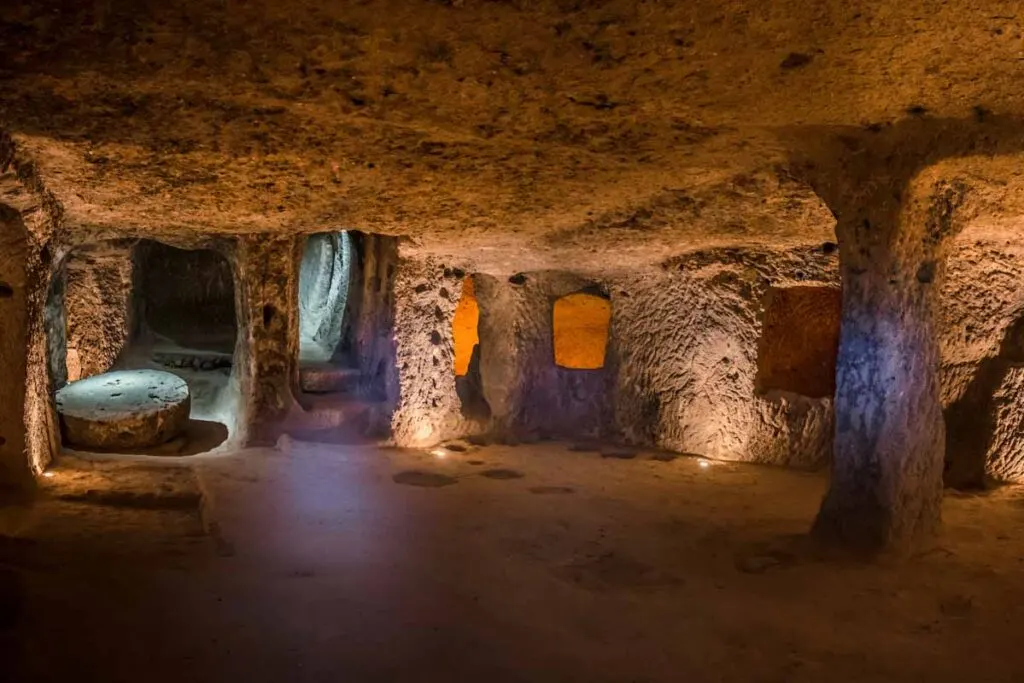Secrets Carved in Stone: Exploring Derinkuyu’s Depths
Embark on an unforgettable expedition into the heart of Derinkuyu Underground City, a subterranean realm hidden beneath the sun-drenched plains of Cappadocia, Turkey. Our photos will be your guide, illuminating the secrets of this ancient marvel and revealing the ingenuity of a civilization that thrived in the Earth’s embrace. Imagine descending into the cool, hushed darkness, leaving behind the familiar world above. Our photos transport you to this extraordinary place, where massive rooms and winding tunnels whisper tales of a distant past.
Derinkuyu underground city photos reveal a world of ingenuity: ventilation shafts that plunge into the earth, carrying life-giving air to the city’s depths; stables where animals were sheltered; oil presses used to extract sustenance from olives; and even cellars where wine was carefully stored. Each image offers a glimpse into the daily rhythms of life for the thousands who once called Derinkuyu home.
The very existence of Derinkuyu speaks to the remarkable skills of its creators. Our photos showcase the architectural prowess required to carve a city from the earth—a network of tunnels so extensive that it likely connected Derinkuyu to other subterranean settlements, forming a hidden world beneath the feet of unsuspecting empires.
But Derinkuyu is more than just an architectural marvel; it’s a testament to the enduring spirit of humanity. It’s a place where innovation met necessity, where fear was met with resilience, and where a community forged a life in the face of extraordinary challenges. Join us as we delve into the heart of Derinkuyu, exploring its mysteries and unearthing the stories etched into its walls.
A City That Breathed: Derinkuyu’s Ingenious Ventilation System
The sheer scale of Derinkuyu, with its 18 levels plunging approximately 85 meters deep, inspires awe. But how did thousands of people survive, hidden from the sun and sky? The answer lies in one of Derinkuyu’s most remarkable features: its ingenious ventilation system.
Over 50 ventilation shafts, strategically positioned throughout the city, acted like lungs, connecting the surface world to the deepest recesses of the underground realm. These shafts weren’t simply holes in the ground; they were carefully engineered to facilitate a constant flow of fresh air.
The system cleverly utilized the natural principle of convection. Warm, stale air, being lighter, would naturally rise through the shafts, drawing in cooler, fresh air from the surface. This continuous cycle ensured that even the deepest levels of Derinkuyu remained breathable, a testament to the ingenuity of its creators.
But these remarkable shafts served more than one purpose. In times of siege, the narrow openings could be easily blocked, preventing invaders from using smoke to flush out those taking refuge within. The ventilation shafts, therefore, were not only essential for life but also served as a crucial line of defense.
Water, another essential element for survival, was also readily available. Wells dug deep into the earth tapped into an underground river, ensuring a constant supply of this life-giving resource. Derinkuyu, therefore, was far more than a mere refuge; it was a city designed for self-sufficiency, capable of sustaining a large population for extended periods.
The Riddle of Abandonment: Why Was Derinkuyu Left Behind?
The precise reason why Derinkuyu was ultimately abandoned remains shrouded in mystery, a puzzle that continues to intrigue historians and archaeologists. While definitive answers remain elusive, a number of compelling theories offer plausible explanations.
For centuries, Derinkuyu served as a vital refuge during the tumultuous era of the Arab-Byzantine Wars. As these conflicts subsided and the Byzantine Empire reasserted control over the region, the need for such extensive underground shelters likely diminished. The allure of life aboveground, with its open skies and freedom of movement, may have drawn people back to the surface.
Maintaining a subterranean city as vast as Derinkuyu would have required significant resources and manpower. As the perceived threat lessened, the effort required to sustain life underground may have become increasingly burdensome, leading to a gradual exodus.
While providing safety and shelter, life in Derinkuyu had inherent limitations. Access to sunlight was nonexistent, agricultural opportunities were limited, and the reliance on a single water source would have created vulnerability. Over time, these challenges may have outweighed the security provided by the underground city.
Disease, too, poses a likely culprit. In a confined environment with limited ventilation, the spread of illness would have been a constant threat. A particularly devastating outbreak may have contributed to the decision to abandon Derinkuyu.
The abandonment of Derinkuyu was likely a complex process driven by a confluence of factors—shifting political landscapes, evolving lifestyles, economic constraints, and the enduring challenges of subterranean living. Whatever the precise reasons, the silence that descended upon Derinkuyu does not diminish its significance. It stands as an enduring testament to human adaptability, ingenuity, and the will to survive.
Illuminating the Depths: How Was Derinkuyu Lit?
The question of how Derinkuyu’s inhabitants illuminated their subterranean world, far removed from the sun’s reach, has captivated the imagination of historians and archaeologists alike. While definitive answers remain elusive, the evidence suggests a combination of ingenuity and adaptation.
Oil lamps, a ubiquitous lighting source throughout history, were undoubtedly essential in Derinkuyu. Archaeological excavations have revealed numerous niches carved into the walls, perfectly sized to hold these flickering flames. The soot and smoke residue found in these niches further support the widespread use of oil lamps.
But oil lamps alone, with their limited reach and smoke production, would not have been sufficient to illuminate the vast expanse of Derinkuyu. This is where the city’s ingenious ventilation system once again played a crucial role.
The shafts that channeled fresh air into the city’s depths also served as rudimentary light wells, guiding slivers of daylight down into the subterranean world. While sunlight could only penetrate so far, these shafts would have provided welcome illumination to the upper levels, reducing the reliance on artificial light sources.
Some researchers have speculated about the intriguing possibility that the inhabitants of Derinkuyu may have harnessed the power of bioluminescence. Certain species of fungi, known to emit a soft, ethereal glow, have been discovered in other ancient underground structures. While no conclusive evidence of bioluminescent fungi has been found in Derinkuyu, it remains an intriguing possibility, hinting at a deep understanding of the natural world and its hidden potential.
The precise methods used to illuminate the entirety of Derinkuyu may forever remain partially shrouded in mystery. However, the evidence suggests a multifaceted approach, combining practical solutions like oil lamps with an ingenious use of natural light and, perhaps, even a touch of bioluminescent wonder.
The Faces of Derinkuyu: Who Called This City Home?
The depths of Derinkuyu have echoed with the footsteps of diverse civilizations, each leaving their mark on this subterranean city. Piecing together the historical tapestry reveals a story of ingenuity, adaptation, and the enduring human spirit.
The earliest traces of human presence in Derinkuyu point toward the ancient Phrygians, a civilization that flourished in Anatolia (modern-day Turkey) during the 8th and 7th centuries BC. It was likely the Phrygians who first began carving out the rudimentary caves that would eventually form the foundation of Derinkuyu.
As centuries passed and empires rose and fell, Derinkuyu’s story intertwined with those of the Greeks and Romans, who expanded upon the existing caves, adding their own architectural styles and expanding the city’s footprint.
The arrival of early Christians in the region during the tumultuous era of the Arab-Byzantine Wars (780-1180 AD) marked a turning point in Derinkuyu’s history. Facing persecution and seeking refuge from the conflicts raging aboveground, Christians flocked to Derinkuyu, transforming it into a symbol of resilience and faith.
During this period, Derinkuyu evolved into a self-sufficient city, capable of sheltering thousands of people for extended periods. Homes, churches, stables, and even schools were carved from the rock, demonstrating a remarkable ability to adapt to life underground.
While primarily used as a temporary refuge during times of conflict, Derinkuyu’s inhabitants created a community bound by shared beliefs and a determination to survive. They established systems for ventilation, water collection, and food storage, demonstrating a remarkable understanding of engineering and resource management.
Derinkuyu stands today as a testament to the enduring human spirit, a testament to the ingenuity and resilience of those who came before us. The faces that once populated its tunnels and chambers may be lost to time, but their story continues to echo through the ages, reminding us of the extraordinary things humanity can achieve, even in the face of adversity.
If you want to learn more about the spartan king who fought pyrrhus, click the link.
- Unveiling the Enigma: Mansoureh Khojasteh Bagherzadeh’s Public Appearances & Private Life in Iran - July 18, 2025
- Unveiling the Mystery: Mansoureh Khojasteh Bagherzadeh’s Husband: A Rare Glimpse into a Private Life - July 18, 2025
- Unveiling Masoud Khamenei’s Mother: Power, Influence, and Iran’s Future - July 18, 2025

















1 thought on “Derinkuyu Underground City: A Photographic Journey Through Turkey’s Ancient Wonder”
Comments are closed.